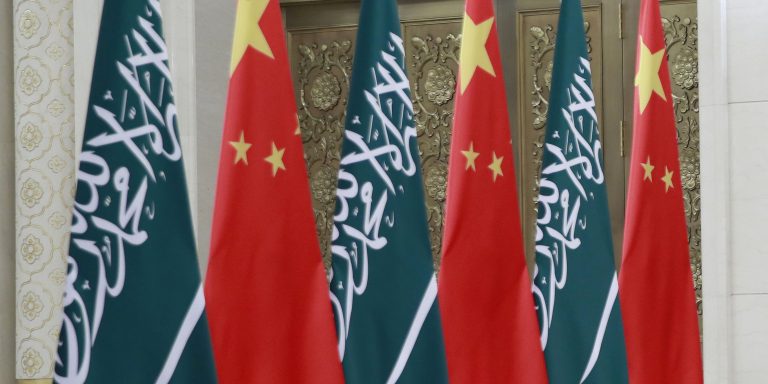INTELBRIEF
January 5, 2022
IntelBrief: Saudi Arabia’s Indigenous Missile Program

Bottom Line Up Front
- The reported Saudi decision to produce ballistic missiles indigenously represents an effort to counter Iran’s expanding missile arsenal.
- Saudi leaders are developing their own missile capabilities rather than rely on a U.S. security umbrella or outside suppliers.
- China has been a supplier of ballistic missiles to the Kingdom in the past and represents a natural partner to assist the new Saudi program.
- The Saudi missile program will introduce new tensions into U.S-Saudi relations.
U.S. intelligence agencies have concluded that Saudi Arabia has begun developing its own ballistic missiles with the help of China, according to recent media reports. Saudi Arabia purchased ballistic missiles from China in the late 1980s, but it has not, until now, established an indigenous production capability. Publicly reported commercial satellite images identified at least one missile production facility near Dawadmi, Saudi Arabia, which reportedly was built with Chinese assistance. These December reports amplify less specific press reporting in 2019 that the Kingdom was engaging in ballistic missile cooperation with China. Apparently confirming the new reports, a spokesperson for China's Ministry of Foreign Affairs told journalists, "Such cooperation does not violate any international law and does not involve the proliferation of weapons of mass destruction."
The Kingdom’s development of an indigenous missile production capacity fits with global experts’ analysis of the Saudi threat perception of Iran’s missile arsenal. U.S. officials have termed Iran’s missile arsenal as “the largest in the Middle East,” and Iran has used that capability to significant effect against the Kingdom. A September 2019 Iranian cruise missile strike knocked out almost half of Saudi oil production for several weeks, and Iran-supplied short-range ballistic missiles fired regularly by the Zaidi Shia “Houthi” movement in Yemen have taken a toll on Saudi infrastructure targets. Saudi leaders seek to ensure that they have an effective countervailing missile force with which to deter future Iranian or Iran-backed strikes on the Kingdom.
The indigenous Saudi missile program raises the question of why Saudi leaders decided to move away from reliance on the U.S. security umbrella in the Gulf to defend against the Iranian missile threat. Among several possible explanations, Saudi leaders were reportedly shocked at the success of the 2019 Iranian strike on Saudi oil facilities, which avoided all U.S. and Saudi-manned detection and missile defenses. Not only did U.S. systems fail to deter or thwart that strike, but over the past four years, the United States has redeployed some missile defense systems from the Gulf to Asia to counter China. Additionally, the U.S. decision to negotiate a re-entry into the 2015 multilateral Iran nuclear agreement, coupled with the U.S. withdrawal from Afghanistan in August 2021, has led Saudi and other Gulf leaders to question the extent and durability of the U.S. commitment to Gulf security. On the related question of why Saudi leaders declined to buy additional finished missiles, U.S. anti-proliferation laws and adherence to global missile proliferation conventions preclude the United States from supplying the Kingdom with ballistic missiles. U.S. secondary sanctions laws apply to outside suppliers, potentially deterring new missile sales to the Kingdom. Saudi leaders appear to have calculated that, in order to avoid a supply disruption, they need to develop their own missile development infrastructure.
Yet, to produce missiles indigenously, Saudi Arabia requires outside technical help, and China is a natural partner to provide that assistance because of its past missile supplies to the Kingdom. In March 1988, it was discovered that Saudi Arabia had bought 50 China-made CSS-2 "East Wind" intermediate range missiles. In 1990, Flight International reported that, according to Israeli intelligence, the CSS-2 missiles were deployed and operational at two sites: al-Sulaiyil, about 500 km south of Riyadh, and al-Joffer, 100 km south of Riyadh. Press reports in 2014 indicated that the Kingdom added to its missile force by purchasing some newer-model Chinese medium-range missiles (DF-21s). Saudi leaders appear to consider China a reliable partner that is willing to risk incurring U.S. sanctions by supplying the Kingdom with missiles and missile technology. China’s Foreign Ministry told U.S. journalists in December that Saudi Arabia and China are "comprehensive strategic partners" and "have maintained friendly cooperation in all fields, including in the field of military trade."
Whether the United States imposes sanctions on Saudi Arabia and/or China for the reported missile cooperation, the Saudi missile program is certain to add strain to U.S.-Saudi relations. U.S. officials have generally avoided the Kingdom’s heir apparent, Crown Prince Mohammad bin Salman (MBS), after concluding that he was behind the October 2018 killing of Saudi exiled journalist Jamal Khashoggi at the Saudi consulate in Istanbul. U.S. officials also have criticized MBS’s erratic policies, including a failed military intervention in Yemen that has caused thousands of civilian casualties and the Saudi and Emirati decision in 2017 to isolate Qatar. The U.S. national security establishment likely has concerns that the Saudi leadership might use an expanding indigenous missile program to pursue an independent Saudi strategy against Iran, with the potential to miscalculate and set off a major regional war. For his part, MBS likely perceives that a Saudi indigenous missile program will prompt the United States to engage in enhanced joint strategic planning with the Kingdom and to reaffirm its commitment to Saudi and broader Gulf security. No matter how U.S. officials respond to the Saudi missile program, if at all, it is certain that the Saudi missile initiative will further complicate U.S. plans to pivot away from the Middle East and focus on great power competition with China and Russia.